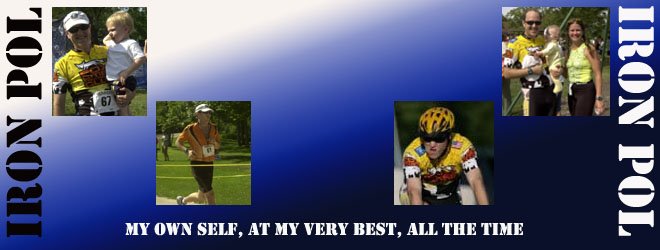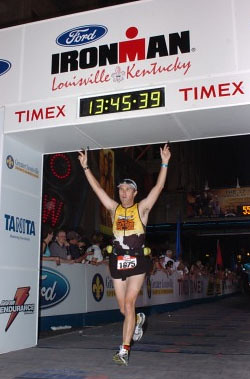Well, the September issue of Triathlete Magazine showed up, yesterday. Reading through it, I walked right into a controversy I wasn't aware even existed. The "Point-Counterpoint" column for this month focuses on the use of altitude training tents to boost the production of red blood cells. The goal is to reduce the impact of SLP-ness our good friend Bolder is so fond of highlighting. Basically, an athlete spending considerable time living or training in this tent does so in the same conditions as somewhat at a much higher altitude, say Boulder, Colorado.
The columnist arguing against the use of what he calls "EPO Tents" claims that this practice is no different than using EPO, a banned substance. However, he is forced to acknowledge that anyone living at higher altitudes experiences the same benefits, naturally. So, manufacturing a low oxygen environment is merely simulating a natural and legal condition. To get around that argument, the author takes the approach that these tents are an unfair advantage due to their cost.
Did I hear that right? The cost of a training tool should lead to its being banned? I will be sending a note to the author care of Triathlete Magazine, as his is the most ridiculous argument I've ever heard.
Let's consider this for just a moment. He claims that altitude training tents, which can run anywhere from $15,000 to (insert sky-high price here), offer an unfair advantage to those able to afford them. Now, as one of the less affluent triathletes of the world, I will certainly agree with the big-picture assessment. Having tons of money certainly offers the chance to "unlevel" the playing field. The question is whether the World Anti-Doping Agency should (or legitimately can) regulate items of this nature.
Money impacts a whole lot more areas that just altitude training tents. How about we start with the swim and work our way through the disciplines?
While far less of a cash-hog than the bike, the swim can be greatly affected by an individual's access to money. Those with little to no disposable income, swims are done as close to au naturale as possible. In other words, they are in swimsuits or tri-shorts. Those who are slightly better off are able to use wetsuits, though they may be very basic models. Those with plenty of extra cash swim in the latest and greatest high tech wetsuits. I'm sure some even have wetsuits custom fitted and made just for them. The same can also be said of coaching. The least affluent learn from any free resource out there. The wealthiest pay for the best coaching money can buy.
Moving through T1, we come to the bike. Oh, the bike. Is there any doubt that money has a serious impact on the bike leg? If so, please compare Natasha Badmann's bike with mine. Now, I love The Pol-R Express. It's a great bike. It is not, however, a $15,000 carbon fiber bike with $3,000 wheels and many thousands of dollars in other components. And while I might not become an elite with such a bike, odds are I'd be much better than I am, today. It is also interesting to note that many of the bikes being used by the top triathletes in the world cost more than the so called EPO Tent.
On to the run, which is sort of the "pristine" event. Short of the type of shoes worn, money will have minimal impact on the run leg. Allowing, of course, for the coaching issue mentioned above.
And then, there's the big picture aspect. Triathletes train long and hard for their races. Some work what training they can into their work or other schedules. They fit training in where they can. And they are limited in the time they can dedicate to that training. Many train in less than ideal conditions. Swim training is often the most difficult, particularly if you are unable to afford a membership to whatever organization has the pool. Others train in perfect conditions (including the lower oxygen conditions of high altitude locations). And the luckiest (and/or best) triathletes train when and where they want. They are either independently wealthy or sponsored professionals. Money plays no role in their decisions.
Is there anyone who wishes to support the notion that having all day, every day to train as needed WON'T make someone a better athlete? That's an argument I won't make. I know I'd be able to improve vastly if my main task in life was to train and get better.
So, while the use of altitude training tents may be controversial, the financial argument is ridiculous. Those of us who are back of the pack age groupers could probably care less about the use of such training aids. Those of us who are truly competitive are probably willing to make the investment if it will help us get that much better. Money plays a huge factor in all areas of triathlon. Those with it aren't guaranteed victory over the less affluent, but they can certainly make the downpayment on a better finish.
Subscribe to:
Post Comments (Atom)











3 comments:
Good points, and you didn't even mention the costs of massage therapists, endless pools, weight training equipment, nutrition supplements, weekend clinics around the country, race entry fees and being able to compete weekly vs monthly, etc. Then what about the athletes whose parents could afford to have them training and racing from a young age. Perhaps they should be dq'd. I would like to see a race with an equalizer though, that gives Badmann my mountain bike and I get to ride her machine-nah she'd still whip me.
Yeah, I think we should give Bolder a two year suspension for illicit performance enhancement practices.
Money talks - it always has. I agree that trying to make these tents illegal is just absurd. What next, carbon fiber bikes and power taps?
As for those tents - wouldn't it just be cheaper to take 3 weeks off of work and go train in Boulder? Heck you could probably get Bold to hold a Celebrity Something and have way more fun than you'd ever have in a tent. Unless you are on a camping trip with the love of your life, that is.
Post a Comment